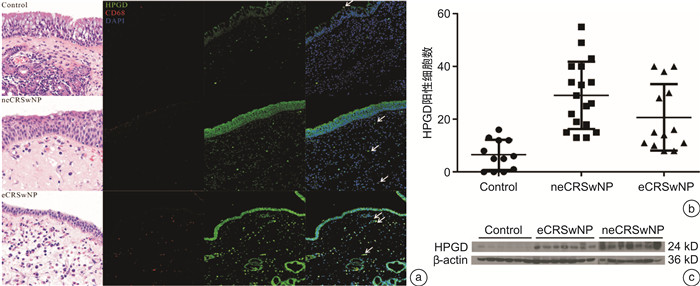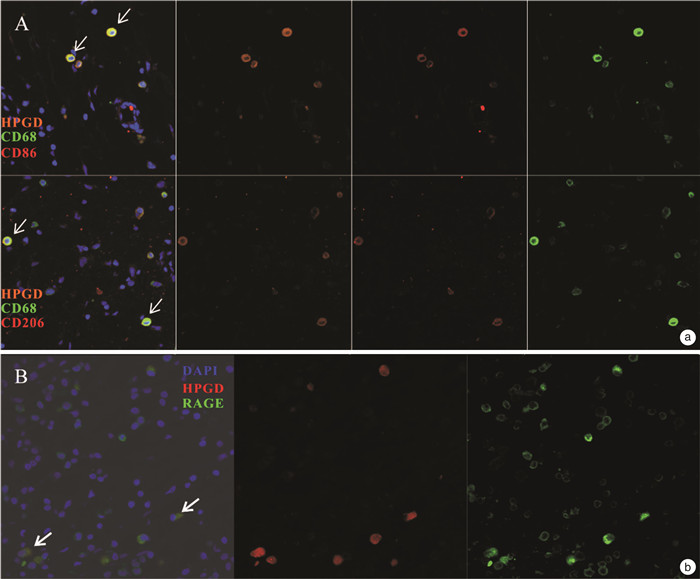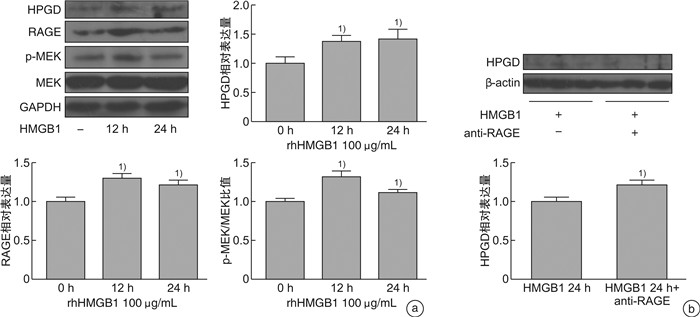Altered expression of 15-hydroxyprostaglandin dehydrogenase in chronic rhinosinusitis with nasal polyps
-
摘要: 目的 研究伴鼻息肉的慢性鼻窦炎(chronic rhinosinusitis with nasal polyps,CRSwNP)患者鼻息肉中15-羟基前列腺素脱氢酶(15-hydroxyprostaglandin dehydrogenase,HPGD)的表达水平及其调控机制。方法 应用免疫荧光观察鼻息肉组织中HPGD表达的细胞类型,应用Western-Blot对鼻息肉组织中HPGD表达进行半定量分析。观察人源重组高迁移率家族蛋白1(high mobility group box-1,HMGB1)对人原代鼻黏膜上皮细胞中HPGD表达的作用,并利用晚期糖基化终末产物受体(receptor for advanced glycation end products,RAGE)中和抗体观察能否阻断HMGB1对HPGD的诱导作用。结果 各型CRSwNP患者中的HPGD表达水平增高,且定位于CD68阳性细胞及上皮细胞。人源重组HMGB1可刺激人原代鼻黏膜上皮细胞中HPGD表达增高,且呈时间依赖性,同时在12 h可观察到MEK的磷酸化水平增高及RAGE表达增高,但在24 h MEK磷酸化水平及RAGE表达趋于正常。利用RAGE中和抗体可部分阻断人源重组HMGB1对人原代鼻黏膜上皮细胞中HPGD的诱导作用。结论 CRSwNP中HPGD表达增高,且主要定位于巨噬细胞及上皮细胞。HMGB1通过RAGE-MEK信号通路调控HPGD表达,这可能为今后调控CRSwNP中PGE2水平提供了一个新的靶点。
-
关键词:
- 慢性鼻窦炎伴鼻息肉 /
- 15-羟基前列腺素脱氢酶 /
- 高迁移率族蛋白1
Abstract: Objective To investigate the expression level and regulatory mechanism of 15-hydroxyprostaglandin dehydrogenase(HPGD) in chronic rhinosinusitis with nasal polyps(CRSwNP).Methods The expression pattern and level of HPGD in CRSwNP and control was observed using immunofluorescence, and western blot was used for analysis of HPGD expression in nasal polyp tissues. The effect of recombinant human high mobility group box-1(HMGB1) on HPGD expression in primary human nasal epithelial cells was observed, and the potential blocking effect of RAGE neutralizing antibody on HMGB1-induced HPGD expression was investigated.Results The expression of HPGD was elevated in CRSwNP patients compared to the control, while the protein mainly localized at CD68-positive cells and epithelial cells. Recombinant human HMGB1 stimulated an increase in HPGD expression in primary human nasal mucosal epithelial cells at a time-dependent manner. Additionally, increased phosphorylation levels of MEK and elevated RAGE expression were also observed at 12 hours, but decreased at 24 hours after the incubation of HMGB1. The increase in the expression of HPGD induced by HMGB1 in primary human nasal epithelial cells was partly inhibited with RAGE neutralizing antibody.Conclusion Elevated HPGD expression is observed in CRSwNP, predominantly in macrophages and epithelial cells. HMGB1 regulates HPGD expression through the RAGE-MEK signaling pathway, potentially providing a new target for future regulation of PGE2levels in CRSwNP. -

-
[1] Fokkens WJ, Lund VJ, Mullol J, et al. European Position Paper on Rhinosinusitis and Nasal Polyps 2012[J]. Rhinol Suppl, 2012, 23: 1-298.
[2] Zhang Y, Gevaert E, Lou H, et al. Chronic rhinosinusitis in Asia[J]. J Allergy Clin Immunol, 2017, 140(5): 1230-1239. doi: 10.1016/j.jaci.2017.09.009
[3] DeConde AS, Mace JC, Levy JM, et al. Prevalence of polyp recurrence after endoscopic sinus surgery for chronic rhinosinusitis with nasal polyposis[J]. Laryngoscope, 2017, 127(3): 550-555. doi: 10.1002/lary.26391
[4] Park JY, Pillinger MH, Abramson SB. Prostaglandin E2 synthesis and secretion: the role of PGE2 synthases[J]. Clin Immunol, 2006, 119(3): 229-240. doi: 10.1016/j.clim.2006.01.016
[5] Roca-Ferrer J, Pérez-Gonzalez M, Garcia-Garcia FJ, et al. Low prostaglandin E2 and cyclooxygenase expression in nasal mucosa fibroblasts of aspirin-intolerant asthmatics[J]. Respirology, 2013, 18(4): 711-717. doi: 10.1111/resp.12076
[6] Miłoński J, Zielińska-Bliz ' niewska H, Przybyłowska K, et al. Significance of CYCLOOXYGENASE-2(COX-2), PERIOSTIN(POSTN)and INTERLEUKIN-4(IL-4) gene expression in the pathogenesis of chronic rhinosinusitis with nasal polyps[J]. Eur Arch Otorhinolaryngol, 2015, 272(12): 3715-3720. doi: 10.1007/s00405-014-3481-9
[7] Xie L, Liu AG, Peng LY, et al. Expression of E-prostanoid receptors in nasal polyp tissues of smoking and nonsmoking patients with chronic rhinosinusitis[J]. PLoS One, 2018, 13(7): e0200989. doi: 10.1371/journal.pone.0200989
[8] Nordström A, Jangard M, Svedberg M, et al. Distinct eicosanoid patterns in severe recalcitrant nasal polyposis[J]. Int Forum Allergy Rhinol, 2023. doi: 10.1002/alr.23181.
[9] Nomura T, Lu R, Pucci ML, et al. The two-step model of prostaglandin signal termination: in vitro reconstitution with the prostaglandin transporter and prostaglandin 15 dehydrogenase[J]. Mol Pharmacol, 2004, 65(4): 973-978. doi: 10.1124/mol.65.4.973
[10] Okita RT, Okita JR. Prostaglandin-metabolizing enzymes during pregnancy: characterization of NAD(+)-dependent prostaglandin dehydrogenase, carbonyl reductase, and cytochrome P450-dependent prostaglandin omega-hydroxylase[J]. Crit Rev Biochem Mol Biol, 1996, 31(2): 101-126. doi: 10.3109/10409239609106581
[11] Banks CA, Schlosser RJ, Wang EW, et al. Macrophage Infiltrate Is Elevated in CRSwNP Sinonasal Tissue Regardless of Atopic Status[J]. Otolaryngol Head Neck Surg, 2014, 151(2): 215-220. doi: 10.1177/0194599814528672
[12] Krysko O, Holtappels G, Zhang N, et al. Alternatively activated macrophages and impaired phagocytosis of S. aureus in chronic rhinosinusitis[J]. Allergy, 2011, 66(3): 396-403. doi: 10.1111/j.1398-9995.2010.02498.x
[13] Kang GJ, Lee HJ, Kang YP, et al. High-mobility group box 1 suppresses resolvin D1-induced phagocytosis via induction of resolvin D1-inactivating enzyme, 15-hydroxyprostaglandin dehydrogenase[J]. Biochim Biophys Acta, 2015, 1852(9): 1981-1988. doi: 10.1016/j.bbadis.2015.07.005
[14] Cho H, Tai HH. Inhibition of NAD+-dependent 15-hydroxyprostaglandin dehydrogenase(15-PGDH)by cyclooxygenase inhibitors and chemopreventive agents[J]. Prostaglandins Leukot Essent Fatty Acids, 2002, 67(6): 461-465. doi: 10.1054/plef.2002.0457
[15] Sun CC, Zhou ZQ, Yang D, et al. Recent advances in studies of 15-PGDH as a key enzyme for the degradation of prostaglandins[J]. Int Immunopharmacol, 2021, 101(Pt B): 108176.
[16] Sagana RL, Yan M, Cornett AM, et al. Phosphatase and tensin homologue on chromosome 10(PTEN)directs prostaglandin E2-mediated fibroblast responses via regulation of E prostanoid 2 receptor expression[J]. J Biol Chem, 2009, 284(47): 32264-32271. doi: 10.1074/jbc.M109.004796
[17] Sturm EM, Schratl P, Schuligoi R, et al. Prostaglandin E2 inhibits eosinophil trafficking through E-prostanoid 2 receptors[J]. J Immunol, 2008, 181(10): 7273-7283. doi: 10.4049/jimmunol.181.10.7273
[18] Kay LJ, Yeo WW, Peachell PT. Prostaglandin E2 activates EP2 receptors to inhibit human lung mast cell degranulation[J]. Br J Pharmacol, 2006, 147(7): 707-713. doi: 10.1038/sj.bjp.0706664
[19] Maric J, Ravindran A, Mazzurana L, et al. Prostaglandin E(2) suppresses human group 2 innate lymphoid cell function[J]. J Allergy Clin Immunol, 2018, 141(5): 1761-1773. e6. doi: 10.1016/j.jaci.2017.09.050
[20] Pérez-Novo CA, Watelet JB, Claeys C, et al. Prostaglandin, leukotriene, and lipoxin balance in chronic rhinosinusitis with and without nasal polyposis[J]. J Allergy Clin Immunol, 2005, 115(6): 1189-1196. doi: 10.1016/j.jaci.2005.02.029
[21] Sun YP, Oh SF, Uddin J, et al. Resolvin D1 and its aspirin-triggered 17R epimer. Stereochemical assignments, anti-inflammatory properties, and enzymatic inactivation[J]. J Biol Chem, 2007, 282(13): 9323-9334.
[22] Levy BD. Resolvin D1 and Resolvin E1 Promote the Resolution of Allergic Airway Inflammation via Shared and Distinct Molecular Counter-Regulatory Pathways[J]. Front Immunol, 2012, 3: 390.
[23] Molaei E, Molaei A, Hayes AW, et al. Resolvin D1, therapeutic target in acute respiratory distress syndrome[J]. Eur J Pharmacol, 2021, 911: 174527. doi: 10.1016/j.ejphar.2021.174527
[24] Chen D, Mao M, Bellussi LM, et al. Increase of high mobility group box chromosomal protein 1 in eosinophilic chronic rhinosinusitis with nasal polyps[J]. Int Forum Allergy Rhinol, 2014, 4(6): 453-462. doi: 10.1002/alr.21294
[25] Bellussi LM, Chen L, Chen D, et al. The role of High Mobility Group Box 1 chromosomal protein in the pathogenesis of chronic sinusitis and nasal polyposis[J]. Acta Otorhinolaryngol Ital, 2012, 32(6): 386-392.
[26] Hirschi-Budge KM, Tsai K, Curtis KL, et al. RAGE signaling during tobacco smoke-induced lung inflammation and potential therapeutic utility of SAGEs[J]. BMC Pulm Med, 2022, 22(1): 160. doi: 10.1186/s12890-022-01935-x
-





 下载:
下载:

